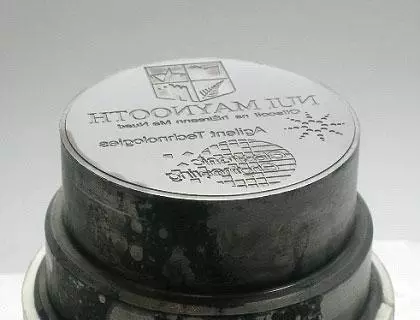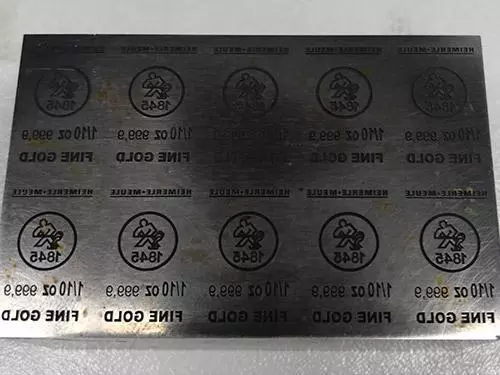Die Polishing - Tungsten Carbide Round & Shaped Wire & Bar Drawing Dies
The problems associated with the shaping of tungsten carbide components originate with its composition. This hard sintered material is usually formed in pallets with the dies form, pre-shaped before the sintering process.
For many decades, die shop operators have lapped with silicon carbide and boron carbide grits and some of the more experienced operators have employed widely graded diamond powder mixed with their favoured oil - mainly olive oil. Many articles were published on this particular technique.
In more recent years Kemet has developed a specialised type of diamond compound to withstand the very high temperatures which are created when lapping tungsten carbide. This particular compound, Type L, utilises the qualities of the other Kemet Diamond Compounds, namely, accurately graded virgin diamond powder particles, individually suspended in a chemically controlled carrier offered with special lubricants to match the chemical carriers. These lubricants and chemicals have been specifically designed to ensure maximum cutting efficiency and allow a predictable step-by-step method approach to lapping and polishing of tungsten carbide dies.
These compounds are offered in controllable dispensers known as Applikators or in small pots known as Dip Jars - similar to the pots in which the die-lappers of the past kept their respective grades of powder - and special stands are available to hold four Dip Jars of different micron sizes of Kemet Type L Diamond Compound. The caps of the Dip Jars are colour coded and engraved with their respective micron sizes.
The traditional laps that have been employed to this type of work, namely, mild steel, copper or brass for removing large amounts of tungsten carbide or shaping a die, and creating large bore sizes, are usually used with the coarse grade or Kemet Type L Diamond Compound and also the personally preferred types of wood may be used for finishing operations using finer grades. Specific recommendations of preferred methods are given later in this paper.
Whether a new pre-formed wire drawing die is being accurately lapped and machined for use or an old die, having been used, is being serviced, many of the operations involved are identical and it is important to understand the practices involved.
Servicing Dies
The angles and bearing lengths are related to the type of material to be drawn, and more important, the reduction to be made in the cross sectional area of the wire. These vary considerably, for instance, when drawing high tensile steel wire, the reduction of cross sectional area is considerably smaller than when drawing non-ferrous material, i.e. copper, brass etc.
When making small reduction to the diameter of the wire it is obvious that the reduction angle should be more acute than when making a large reduction, in this way the work ring eventually developed is kept well away from the entrance to the bearing, which in turn, should be longer than normal.
These previously mentioned points are important since when servicing a die which has been worn or damaged during the drawing process, the amount of material that necessarily has to be removed from the die obviously controls the life of the die. Therefore it is imperative that the damage in a die should be assessed as early as possible as to when it should be reconditioned and serviced.
Round Dies
If it is decided that the work will be done by hand the die is rotated in a chuck at 1,500 r.p.m. and if the chuck is fitted with a brake it will save time in the lapping and polishing operations.
It should be recognised that the cleaning before and in between any of the grinding and polishing operations hereafter mentioned, must be thoroughly adhered to and it is recommended the die be cleaned with Kemet Cleaning Fluid.
Whether it is for lapping a new die which has been roughly preformed in the sintering process - this includes bell mouth, reduction angle, bearing and back relief angle - or whether it is for the servicing of a work damaged die, 45 micron Kemet Type L Diamond Compound should be used on a lap of steel, brass or copper or Kemet hard lapping sticks until the correct angle has been achieved or the work ring removed. The lap should then be stored in a suitably marked container as to its grade of diamond compound so that it can be used for further work. The lap itself should not have a variation of more than half a degree from the intended reduction angle otherwise the life of the die can be greatly reduced.
A steel needle is often used if the die has to be reshaped to a new angle or if a heavy work ring has developed, otherwise the hard wood lapping sticks plunged into the die and then the diamond compound applied to them will usually suffice for this coarse lapping operation.
The new reduction angle having been developed may reduce the length of the bearing and therefore this may have to be re-cut from the exit side with the same grade of diamond compound. We now have a die where all contact surfaces have been roughly cut and remain to be polished.
It is emphasised once again that the die must now be thoroughly cleaned with Kemet Cleaning Fluid or similar materials to remove all the abrasive slurry left in the rough lapping stage.
The clean die can then be replaced in the chuck and the exit angle polished in the following manner - cut a Kemet soft lapping stick or suitably sized softwood, until it just fits the exit angle, apply a little fluid, then press lightly into the exit until the form of the angle is formed on the wood, cut off any part of the wood which has been pressed into the bearing as this would affect the size of the bore if allowed to lap the bearing. Then apply a little 3 micron Kemet Diamond Compound and by making a series of short, sharp jabs into the exit angle with the wood, the angle will be polished in a matter of seconds.
Then turn the die round so that the entrance angle is open to the operator and again cut a piece of soft timber until it almost fits the reduction angle, apply fluid and again press into the die, so that the wood completely fills the reduction angle. Again, cut off any wood which has been pressed into the bearing, then apply 3 micron Kemet Diamond Compound to the wood, and with the same system of short, sharp jabs into the die, the reduction angle will be polished in just a few seconds.
The die is then cleaned with Kemet Cleaning Fluid, checked for size and ready for use.
Shaped Dies
Square, hexagon and multiple shaped dies are held in a vice, then processed by the same Kemet method as the round dies. In this case three grades of Kemet Type L Diamond Compound are necessary, namely, 45 micron, 14 micron, and 3 micron, and either lapped by hand with hand lapping sticks, using a tool holder type, or with reciprocating tools such as the Diprofil reciprocating polishing head. When using the latter, one can also employ Kemet diamond plated files to shape and develop the exact size required prior to diamond compound lapping and polishing.
Using 45mu Kemet Diamond compound on the harder range of laps can be used to pre polish the die after thorough cleaning of the die and storage of the laps as previously described, a 14 micron diamond compound is employed with hard wood to further pre polish with the Diprofil Reciprocating Head. Once again, after thorough cleaning and storage of the laps for further use, in pre-marked containers, the final polishing stage of 3 micron diamond compound, using balsa wood or soft wood laps, should be employed to achieve the high finish.
With other intricately shaped dies, it is only possible to use hand lapping. Whilst this is tedious, the diamond compound will be found to reduce the normal lapping time generally needed with non-diamond abrasives. A useful approach to this problem is to employ the method of using a 45 micron diamond compound on a mild steel, copper or brass hand lap. Once the die has been cleaned and the lap stored for future use, a 14 micron compound is used with hard wood shaped to the form necessary for lapping. Again, after the cleaning operation and storage of the lap, a similar soft wood lap with 3 micron compound will achieve a high finish.
Whilst this article has dealt mainly with tungsten carbide, many hardened steel extrusion dies for aluminium and other metals employ exactly the same techniques described herein.
Producing Mirror Finish To Coin Dies
Test Requirements:To produce a mirror polish on Steel Coin Dies.
Component/Material: 3 x Coin Dies
Stage 1
Machine Type: Kemet 15” diamond lapping/polishing machine
Lap Plate: Cast Iron
Abrasive Type/Grade: Kemox O-800 (Fine) aluminium oxide lapping suspension.
Stage 2
Machine Type: Kemet 15” diamond lapping/polishing machine
Lap Plate: ASFL synthetic silk polishing pad
Abrasive Type/Grade: 3µ Type K Kemet diamond slurry
| Process Breakdown | |||
|---|---|---|---|
| Stage | Plate/cloth type | Abrasive type/grade | Process time |
| 1 | Cast Iron | Kemox O-800 | 10-20 minutes from ground surface |
| 2 | ASFL-K Polishing pad | 3µ Type K Diamond slurry | 5-10 minutes depending on size minutes |
For this trial we have used our standard flat Die polishing process. A process used at various Mints throughout Europe. The lapping times on the Dies supplied was extended because of the poor flatness to start with, but from ground we would expect no more than a 20 minute lapping time. A single machine can be utilised for both process stages, as the ASFL silk polishing cloths are self adhesive, meaning they can be fixed to the lapping plate once a batch of Dies have been lapped.
As with all lapping processes, the lapping plate flatness is key to maintaining acceptable lapping stage times, so I would recommend the purchase of a Kemet plate Flatness Gauge, should you decide to go ahead with the purchase of a lapping/polishing system.
We would also recommend an Ultrasonic cleaner for part cleaning between stages to ensure there is no cross contamination between stages. Any abrasive from stage 1 that is carried over to the ASFL pad will mean that the pad has to be changed. An ultrasonic cleaner will ensure that there is no abrasive from stage 1 left within the engraving.
Before Polishing Coin Die

After Polishing Coin Die

Polishing Die Stamps - Case Study
Test Requirements: To polish die stamps.
Equipment used:
- Kemet 15” lapping/polishing machine
- Kemet XP, 15” diameter Lapping plate
- Kemet Flatness gauge
- Kemet Liquid diamond 6 micron Type K STD
- ASFL polishing pad, 15” diameter
Process Breakdown
Each die was fixtured using Dycem on a 4kg weight and run on Kemet XP plate, Run Time: 20 minutes. Ra reading after this stage 0.0132 μm. 1 die was additionally polished on an ASFL polishing pad which was fixtured using Dycem on a 4kg weight, Run time: 5 minutes. Ra reading after this stage 0.0031 μm
Before & After Polishing Stamp Die





